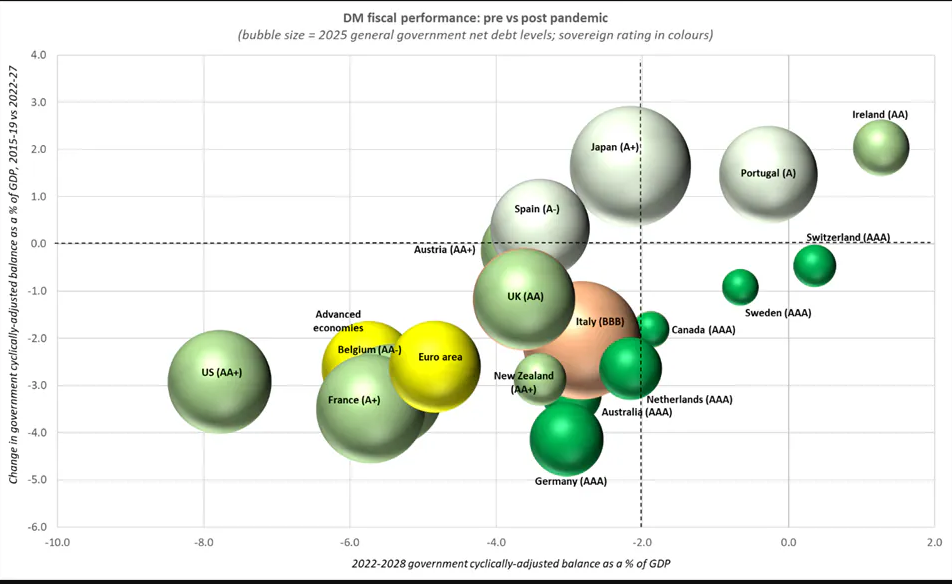A year after her 2024 shocking prediction Kellie Wood says the real crisis may still lie ahead
When Schroders’ Kellie Wood took the stage at Livewire Live in 2024, she issued one of the boldest calls of the event:
A 50% probability that the United States would enter recession within 12 months, potentially triggering a sovereign default, a moment she described as “the mother of all crises.”
It was a warning that seized the room. At a time when equity markets were pricing in a soft landing and the resilience of the US economy seemed unshakeable, Wood forced investors to address an uncomfortable truth: the world’s largest economy was on an unsustainable fiscal path, and the next downturn could expose its greatest vulnerability.
Twelve months on, that recession has not materialised. The crisis has not erupted. Yet according to Wood, the core risk has not been eliminated, only deferred.
“US growth has held up, inflation has continued to moderate, allowing the US Fed to ease policy rates,” Wood reflects.
“With both the government and central bank delivering on a high-pressure economy, US recession risk has reduced to 25% according to our Schroders dashboard.”
As Portfolio Manager of Schroders’ Fixed Income Fund, Wood spends every day navigating these macro crosscurrents. In this conversation, she explains why the debt problem has not gone away, what could still trigger the sovereign crisis she warned of, and how fixed-income investors should position for what comes next.

A year of surprising resilience
Wood attributes the United States’ resilience to the extraordinary consumer strength, driven by wealth gains, falling savings rates and a balanced employment market.
“It has been personal consumption expenditure that has been driving a lot of this growth, the US consumer has been supported by wealth gains, a lowering of savings rates and a balanced job market.”
This dynamic has allowed the Federal Reserve to begin easing without damaging confidence. But Wood is careful to note that this is not a return to normal, nor is the US on a stable long-term path.
Is the sovereign default still a real risk?
At Livewire Live in 2024, Wood’s central warning was not merely about recession; it was about the consequences of recession when layered atop unprecedented sovereign debt levels.
Today, she is clear: the risk still exists.
“Never say never! US debt to GDP is above 120% and rising. Factors like growing debt, political gridlock and decreased demand for US debt have increased the risk.”
However, the system can continue functioning, she argues, so long as nominal growth exceeds interest costs.
“As long as growth remains above the rate of interest, then US debt levels will remain sustainable. The US government needs to continue to deliver on a high-pressure economy to ensure nominal growth rates remain elevated.”
In other words, the US must keep running hot to avoid a fiscal accident. That is not a comfortable equilibrium; it is a delicate balancing act.
Financing continues, but not without cost
Despite rising debt levels, markets continue to finance the US, even if they are beginning to demand more compensation for doing so.
“We are still pushing the boundaries of unsustainable debt levels but markets, for now, still appear willing to finance it, albeit may want higher risk premium to fund the US government.”
As the chart below illustrates, the US sits among the most fiscally challenged developed economies, with deteriorating budget balances and rising net debt.
.png)
Recent “flight to quality” episodes have only reinforced the paradox. In times of stress, investors still rush to US treasuries, the very instrument that sits at the heart of the crisis narrative.
“Only this week we have seen the safe haven status and flight to quality come back to US treasuries on risk off market moves that has increased demand. US Treasuries are still the most liquid, deep and trusted sovereign instruments globally.”
But Wood warns of a key tipping point.
“The risk is higher real interest rates exceeding growth; debt will accelerate upward uncontrollably. The near-term risk is if inflation reaccelerates and the US Fed is stopped out of its easing cycle.”
Was her 2024 positioning right?
Last year, Wood suggested diversifying away from US assets and increasing exposure to inflation protection. The past 12 months have largely validated that positioning.
“Liberation day and a substantial increase to the US effective tariff rate was the catalyst for the end of US exceptionalism to be priced into markets, with US Equities down close to 20% in Q2/Q3 this year, which has since rebounded.”
While equities have staged a recovery, the more important signal has been the weakening US dollar and the outperformance of gold.
“The trade that has reflected the end of US exceptionalism is the weaker US Dollar. Inflation protection has been best played via gold with the current macro uncertainty.”
For fixed-income investors, Wood believes the cycle has changed. Rate cuts are no longer the primary driver. Instead, credit selection and sovereign risk are coming to the fore.
The debt fuse tightens
Wood also warned in 2024 about the insolvency timelines facing major US entitlement programs such as Social Security and Medicare, with trust funds potentially exhausted by the early 2030s.
One year later, little has changed.
“The timelines are getting closer, and while there have been reform proposals, no structural fix is yet in place that ensures full solvency.”
Political gridlock is the core challenge.
“Unless Congress acts in the next few years with credible plans and bipartisan support, beneficiaries will eventually face either reductions in benefits, increased taxes, or both.”
This looming showdown is not just a domestic issue; it is a key determinant of future Treasury issuance, debt sustainability, and the long-term path of yields.
A crisis paused, not cancelled
Wood’s original prediction – that the US had a 50:50 probability of recession triggering sovereign default – has not played out in the timeframe she anticipated. But it hasn’t been invalidated. If anything, the fiscal foundations underpinning her call have only grown more stretched.
The US avoided recession not because its vulnerabilities disappeared, but because policymakers continued to deliver elevated nominal growth. That solution bought time, but also deepened the structural challenge.
Today, Wood believes the immediate risk has eased from 50% to 25%, but the long-term threat remains firmly intact.
As she puts it: “We are still pushing the boundaries.”
Her conclusion is clear. This is not a moment for complacency. It is a time to be selective, active and conscious of sovereign risk.
The mother of all crises hasn’t arrived, but according to Wood, the fuse is still burning.
5 topics
1 contributor mentioned

